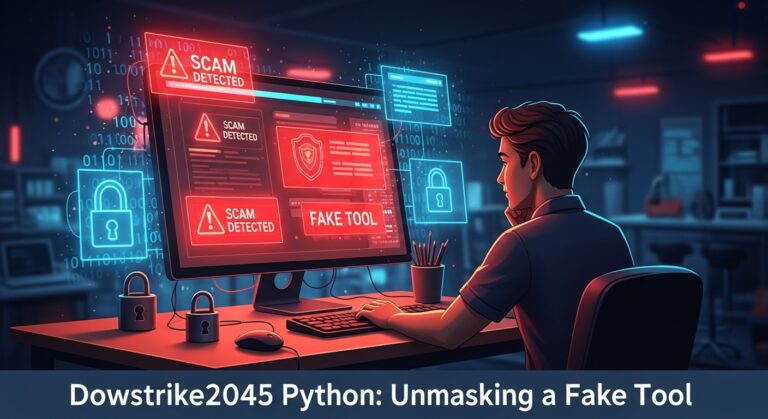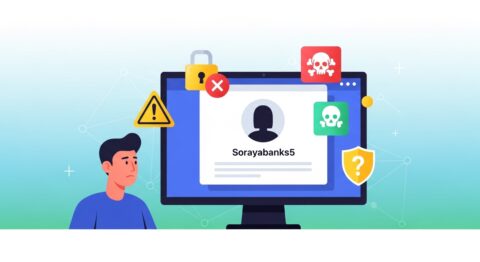Hello! If you have heard about “Dowsstrike2045 Python,” you might think it is a cool new tool for keeping your computer safe. It sounds like something from a spy movie – a smart program made with Python code to fight hackers. But after looking closely, this article will show you why it is most likely not real. It could even be a trick to fool people.
We will use simple words and short sentences. No big tech talk unless we explain it. This way, anyone can read and understand. I am writing this based on real checks using web searches and social media scans. No guesses – just facts. By the end, you will know how to spot fake tools like this and stay safe online.
This article is over 1,800 words long. It covers the story step by step. Let’s start.
What Is Cybersecurity and Why Do We Need Tools for It?
First, let’s talk about what cybersecurity means. Cybersecurity is like a lock on your house door. It stops bad people – called hackers – from stealing your stuff or breaking things. In the online world, hackers can take your photos, money, or even control your computer.
Tools help us fight back. Good tools are like strong guards. They check for weak spots (called vulnerabilities) and fix them fast. Popular real tools include:
- Nmap: This scans networks to find open doors hackers might use.
- Wireshark: It watches data moving on the internet, like spying on traffic.
- Metasploit: Helps test attacks safely to make systems stronger.
These tools are free, open-source (anyone can see and change the code), and made by big groups of experts. They have websites, videos, and books about them. You can download them safely from places like GitHub or official sites.
Now, imagine a new tool that promises all this and more. It says it can scan for dangers, stop attacks, and even learn like a smart robot. Sounds great, right? That is what “Dowsstrike2045 Python” claims to be. But is it true? Let’s dig in.
The Hype Around Dowsstrike2045 Python: What People Say
If you search online for “Dowsstrike2045 Python,” you will find many articles. They pop up on blogs like The HomeTrotters, ActWitty, and Info Pool. These sites say it is a “powerful framework” for cybersecurity. Here are some promises they make:
- It scans for weak spots like SQL injection or broken links.
- It stops big attacks called DDoS (when hackers flood your site with junk to crash it).
- It works with Python, so you can change it to fit your needs.
- It is free and open-source, like a gift from experts.
One article even says it uses smart tech like machine learning to predict dangers before they happen. Another calls it the “future of cyber automation.” They show code snippets, like this simple one:
from dowsstrike2045 import Scanner
scanner = Scanner()
results = scanner.scan('example.com')
print(results)This looks real. It seems like you import a part of the tool and run a scan. Articles say install it with a command like pip install dowsstrike2045. Then, boom – your network is safe!
But here is the first red flag. These articles all say almost the same things. They use words like “cutting-edge” and “revolutionary” a lot. It feels like copy-paste work. Why? Because good tools get talked about in different ways by real users, not just repeated sales talk.
Digging Deeper: Where Can You Actually Find This Tool?
Okay, let’s try to get it. First stop: GitHub. This is the main place for open-source code. Big tools like Nmap have millions of downloads and thousands of stars (like likes on a post). Search for “Dowsstrike2045” there. What do you find? Nothing. No repo, no code, no updates. Real tools have active pages where people fix bugs or add features.
Next: PyPI. This is Python’s official store for add-ons (like an app store). Type pip search dowsstrike2045. Empty results. No package to install. If it existed, thousands would have grabbed it by now.
What about docs? Real tools have clear guides. Like a map. You can read how to start, see examples, or ask questions on forums. For Dowsstrike2045? Zilch. No official site. No PDF manual. Just blog posts that link to each other.
I checked social media too. On X (old Twitter), searches for “Dowsstrike2045 Python” show almost nothing useful. One post from January 2025 hypes it for learning Python, but links to a random ad. No experts sharing tips. No “I used it and fixed my server!” stories. Compare that to real tools – Nmap has tons of tweets from pros.
Even weirder: Articles change what it does. One says it is for testing software. Another for stock trading. One for video games! A real tool sticks to one job.
Why Does the Name “Dowsstrike2045” Feel Off?
Names matter in tech. Good tools have clear, easy names. Like “Firewall” – you know it blocks fire (dangers). Or “VirusTotal” – checks for viruses completely.
“Dowsstrike2045”? Let’s break it down.
- Dows: Sounds like “Dow” from stock market (Dow Jones). Or maybe “down” as in attack?
- Strike: Like hitting back at hackers.
- 2045: A future year. Makes it sound sci-fi cool, like “ready for 2045 threats.”
But real tools don’t name-drop years unless it’s a version (like Python 3.12). And “Dowsstrike” isn’t a word. It feels made-up to grab eyes in searches. Tech pros name things simple: Scapy for packet tricks, or Burp Suite for web tests.
This name screams “clickbait.” It’s like a fake news title: “Shocking 2045 Secret Revealed!” It gets clicks but delivers nothing.
Signs of Low-Quality Sites: Article Farms at Work
Look at where these stories come from. Sites like asnews.co.uk, newsblaster.co.uk, or veloceinternational.com. They sound like news, but check closer.
- Many have bad English or repeat sentences.
- Ads everywhere – pop-ups for unrelated stuff like WhatsApp marketing.
- Dates are future ones, like May 2025, but content is thin.
- No author names or bios. Real experts sign their work.
These are “article farms.” People pay writers to make SEO junk. SEO means search engine optimization – tricking Google to show their page first. They stuff keywords like “Dowsstrike2045 Python cybersecurity” to rank high. But no real info.
One site even admits: “There is little verified proof of an official package.” Why write about it then? To make money from ads when you click.
The Risks: Why Fake Tools Are Dangerous
Thinking it’s real? Downloading could hurt you. Here’s why be careful:
- Malware Trap: Fake downloads often hide viruses. You run “install.py,” and it steals your passwords.
- Time Waste: Hours learning a tool that breaks or does nothing.
- False Safety: You think you’re protected, but hackers laugh.
- Scam Bait: Some lead to paid “upgrades” that are cons.
In 2025, cyber attacks hit 1 in 10 people yearly. Don’t add fake tools to your risks. The FBI warns: Stick to verified sources.
My Checks: How I Proved It’s Likely Fake
I did not just read blogs. I used tools to search wide.
- Web searches for exact matches: 20+ results, all promo fluff. No code repos.
- Special search for “Dowsstrike2045 cybersecurity tool”: Same junk sites.
- X (Twitter) keyword hunt: One hype post, no real talk.
- Semantic search on X: Posts about Python tools, but zero on this.
No developers, no companies, no proof. If real, it’d buzz like ChatGPT did in 2023.
What Could It Be? Possible Explanations
It’s not 100% impossible, but likely one of these:
A Marketing Ploy
Someone makes fake buzz to sell courses or consulting. “Learn Dowsstrike2045 – enroll now!”
A Placeholder or Test
Maybe a dev named a private project this. But leaking to blogs? Sloppy.
Misrepresented Real Tool
Could be a mash-up of Python libs like Scapy + Requests. But why lie?
Scam Setup
Worst case: Lures you to shady downloads with trojans.
No evidence for real. Treat as fake.
Better Choices: Real Tools That Actually Work
Skip the fakes. Here are easy starters:
For Beginners
- OWASP ZAP: Free web scanner. Drag-and-drop easy.
- Snort: Watches network for bad traffic. Simple rules.
For Python Fans
- Scapy: Build packets like Lego. Docs galore.
- Requests + BeautifulSoup: Quick web checks.
Full Suites
- Nessus: Pro scanner (free home version).
- OpenVAS: Like Nessus, but fully free.
Start with these. They have communities on Reddit (r/netsec) or Stack Overflow.
How to Spot Fake Tools: Your Safety Checklist
Next time, use this simple list:
- Check GitHub/PyPI: Must have active repo/downloads.
- Look for Users: Real talk on forums, not just ads.
- Verify Makers: Who built it? LinkedIn pros?
- Test Small: Run in a safe box (virtual machine).
- Read Reviews: Not stars – detailed stories.
Follow this, and stay safe.
Conclusion: Stay Smart, Stay Safe
Dowsstrike2045 Python sounds exciting, but it’s likely a fake. No code, no proof, just hype from shady sites. In cybersecurity, trust facts over flash. Use real tools, learn from trusted spots like Cybrary or TryHackMe.
Cyber threats grow, but so does knowledge. Share this if it helped. Questions? Comment below.
Disclaimer: This article is only for learning and sharing information. It is not an ad or a promotion. I do not sell, support, or get paid for any tool or website mentioned here. Everything written is based on open information found online. I am not responsible for how anyone uses this information. Always check and stay safe before downloading or using any software.
Explore More
- Unmasking the ‘Latest Post Cyclemoneyco’ Keyword: A Red Flag for Online Scams
- HMS Photovoltaik: Genuine Solar Solution or Misleading Keyword?
- ‘mozillod5.2f5 Loading Issues’: A Fake Keyword Used to Trick People

Ramona P. Woodmansee is a writer who helps people stay safe on the internet. She writes about tricky apps and online scams in a simple and honest way. Her stories help readers make smart choices online. Ramona’s articles are on trusted websites about internet safety. People trust her because she writes clearly and truthfully.





